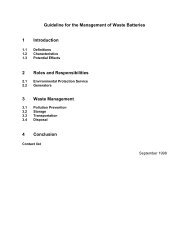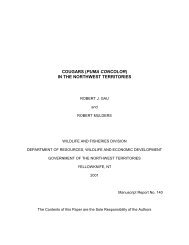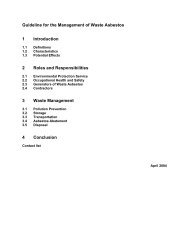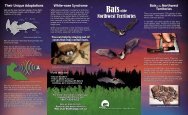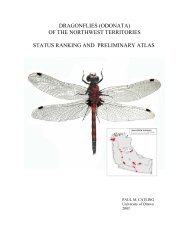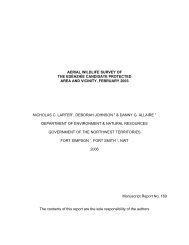Standard Operating Procedure (SOP) - Environment and Natural ...
Standard Operating Procedure (SOP) - Environment and Natural ...
Standard Operating Procedure (SOP) - Environment and Natural ...
- No tags were found...
Create successful ePaper yourself
Turn your PDF publications into a flip-book with our unique Google optimized e-Paper software.
<strong>St<strong>and</strong>ard</strong> <strong>Operating</strong> <strong>Procedure</strong> (<strong>SOP</strong>)<br />
Capture, H<strong>and</strong>ling & Release of Bears<br />
Wildlife Care Committee Primary Author: Dr. Marc Cattet Version 2 - 2011<br />
<br />
<br />
The best fit is usually achieved when the collar is as tight as possible, but still<br />
able to be pulled over the head (Reynolds et al. – unpublished report). A<br />
collar that is snug but not too tight at the width of the zygomatic arch (i.e.,<br />
finger’s width between the collar <strong>and</strong> zygomatic arch on either side) will<br />
generally ensure that the collar will be loose enough to accommodate the<br />
seasonal increase in body mass. If bears are fitted with collars when they are<br />
in poor condition (e.g., in a year following a food-failure year), investigators<br />
should ensure there is enough space between the collar <strong>and</strong> the neck to<br />
accommodate a large gain in body mass in a good food year. Further, male<br />
polar bears <strong>and</strong> some male grizzly bears cannot be fitted with telemetry<br />
collars due to the width of their neck in relation to their skull. However, ear<br />
tag transmitters can be applied to these animals instead.<br />
Conventional VHF collars should not be deployed unless funds have<br />
been procured to monitor the collars for the length or majority of the<br />
battery life.<br />
Conventional VHF collars should not be fitted on bears if funding is not<br />
sufficient to ensure that radio locations will be recorded at a rate (i.e., number<br />
of locations per unit time) that will adequately meet the study objectives.<br />
If ear tag transmitters must be used to meet the study objectives, the<br />
transmitter weight should be as light as possible (



